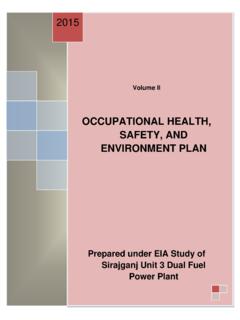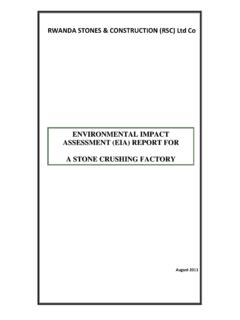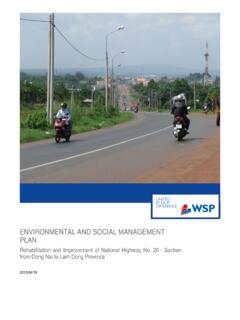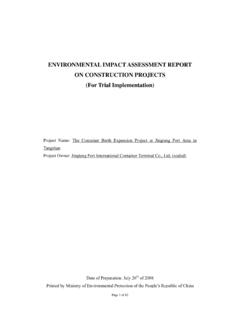Transcription of Integrated Management System Manual - MIGA
1 Document No.: GRP-EHS-M Version: 01 Date: 12/1/2020 Integrated Management System Manual Bluebird Holding Limited Integrated Management System Bluebird Holding Limited Integrated Management System GRP-EHS-M Version: 01 Integrated Management System Manual 0 01/11/2020 IBIS Consulting Lloyd Manhivi Nazaire Atse REV. DATE AUTHOR CHECKED SIGNATURE APPROVED SIGNATURE MODIFICATION DETAILS Confidential Internal Public This document is a property of Bluebird Holding Limited and shall not be used, reproduced, transmitted, or disclosed without prior permission from Bluebird Holding Limited. Bluebird Holding Limited | Integrated Management System Manual Table of Content Rev. 01 | Published on: 12/1/2020 Page 1 TABLE OF CONTENTS 1 IMS Scope .. 1 IMS Introduction.
2 1 IMS Scope .. 2 2 Normative Reference .. 3 3 Terms and Definitions .. 4 4 Context of Organisation .. 5 Organizational context .. 5 Understanding the Needs and Expectations of Interested Parties .. 5 IMS Architecture .. 6 5 Leadership .. 9 Leadership and Commitment .. 9 Environmental, Health and Safety, and Social Policy .. 10 IMS Organisational Structure .. 12 General Responsibilities .. 12 Individual Roles and Associated Responsibilities .. 13 6 Planning .. 17 Hazards Identification and Risks Assessment Procedure .. 17 Introduction and risk Management principles .. 17 Application of the Control 18 Group Level Risk Assessment .. 19 Site Level Risk Assessments .. 20 Risk Assessment Methodologies .. 20 Review and Update of Risk Assessments .. 22 EHS Compliance Obligations Review and Management Procedure .. 22 Procedure.
3 23 Planning Action .. 24 Setting E&S Objectives .. 27 Group Level Objectives .. 27 Site Level Objectives .. 27 SMART Objectives .. 28 Communicating Objectives .. 29 Planning to Achieve E&S Objectives .. 29 Monitoring and Reporting of Progress of Objectives .. 29 7 Support .. 29 IMS Resources .. 29 Training, Capacity and Awareness Management Plan .. 30 Communication .. 32 Bluebird Holding Limited | Integrated Management System Manual Table of Content Rev. 01 | Published on: 12/1/2020 Page 2 Internal Communication .. 32 External Communication .. 33 Document Control Procedure .. 34 Document Numbering and Identification .. 34 Document Structure and Format .. 35 Document Approval .. 36 Review .. 36 Printing of Documentation .. 36 Documents of External Origin .. 36 Document Protection .. 36 Record Retention Requirements.
4 37 8 Operation .. 37 Operational Planning and Control .. 37 Environmental Management .. 38 Occupational Health and Safety Management .. 38 Community / Public health and safety .. 39 Decommissioning .. 39 Stakeholder Management .. 40 Identification and Analysis .. 40 Mapping and Prioritization .. 41 Stakeholder Risk Assessment .. 42 Stakeholder Engagement Plan (SEP) .. 42 Implementation and Monitoring .. 42 Internal and External Communication .. 42 Grievance Management Procedure .. 42 Procedure .. 42 Communication .. 45 Security Management .. 45 Procurement and Supply Chain Management .. 46 Existing suppliers: .. 47 New Suppliers .. 49 Emergency Preparedness and Response .. 49 Change Management .. 51 9 Performance Evaluation .. 53 Performance Monitoring and Reporting Framework .. 53 Reporting to Group .. 55 Monitoring and Measurement Equipment.
5 55 Evaluation of Compliance .. 55 Reporting Non-compliances to Group .. 56 Bluebird Holding Limited | Integrated Management System Manual Table of Content Rev. 01 | Published on: 12/1/2020 Page 3 Internal Audit .. 56 Corporate EHS and Social Audit Programme .. 56 EHS and Social Performance Data Verification .. 56 IMS Management Review .. 56 10 Improvement .. 58 Incident, Nonconformity and Corrective action .. 58 Incidents and Near Misses .. 58 Non-conformances .. 58 Continual improvement .. 61 List of Figures Figure 4-1: IMS Architecture .. 8 Figure 6-1: The Control Hierarchy .. 19 Figure 6-2: Overview of the 3-tiered risk assessment approach applied at site level .. 20 Figure 6-4: Planning Action Process Flow .. 25 Figure 6-5: SMART objectives - questions to consider .. 28 Figure 7-1: Training Process Flow .. 31 Figure 8-1: Stakeholder Mapping Matrix example.
6 41 Figure 9-1: Process Flow for Performance Monitoring .. 54 Figure 10-1: Process for managing non-conformances .. 60 List of Tables Table 1-1: BBHL IMS Scope .. 2 Table 5-1 Summary of IMS role and responsibilities .. 13 Table 7-1: Document Identification Nomenclature .. 34 Table 7-2: Document Retention Periods .. 37 Table 8-3: Grievance Levels .. 44 Table 8-4: Supplier Significance guide .. 47 Table 8-5: Change Management 52 Table 9-1: Incident/Accident/Event Reporting Timeframes .. 55 Bluebird Holding Limited | Integrated Management System Manual IMS Scope Rev. 01 | Published on: 12/1/2020 Page 1 1 IMS SCOPE IMS Introduction Blue Bird Holding Limited (BBHL) is a Fast-Moving Consumer Goods manufacturer and healthcare company focusing on the Ethiopian market. The portfolio of companies includes manufacturing of edible oil, soap and detergent, food products and beverages.
7 Our vision is to improve life and livelihood of the communities by providing world-class products and services for now and future generations. We recognise the escalation of various global sustainability challenges, specifically current and potential risks and impacts from climate change, increasing resource scarcity, and pressure on land, water and forests from economic development carried out in an unsustainable manner. We further acknowledge the impact our operations can have on the environment, our workforce, and the communities in which we operate. BBHL therefore commits to deliver sustainable growth and operate our business in an environmentally sound and sustainable manner, through continuous improvements in environmental and social performance in all our activities, ensuring the safety and rights of our workforce, and the communities in which we operate.
8 The Integrated Management System (IMS) has been developed in line with requirements from the International Finance Corporation (IFC) Performance Standard 1: Assessment and Management of Environmental and Social Risks and Impacts (PS 1), as well as ISO 14001:2015 Environmental Management Systems and ISO 45001 :2018 Occupational Health and Safety Management Systems. The purpose of the IMS is to provide the framework to enable safety, health and environmental (EHS) and social risks to be understood, and mitigation measures developed, implemented and appropriately managed. Collectively, the IMS will assist BBHL and its operations to comply with relevant authorisations, legal requirements, the IFC Standards and other obligations in a systematic and structured framework. The IMS constitutes a flexible Management approach that can readily accommodate the changing needs of BBHL and its operations.
9 This document therefore intends to: 1. Clearly identify and define the IMS scope applicable to BBHL and its operations; 2. Identify and outline the Group level policies, procedures and Management plans to be applied at Group and operational level; 3. Provide guidance and direction for the implementation and operation of the IMS; 4. guide Group and site Management in assessing and evaluating the effectiveness, suitability and adequacy of the IMS and conformance to the requirements from IFC Performance Standards and the ISO 14001 and ISO 45001 Management System standards; and 5. Provide the framework that enables a dynamic IMS System to be implemented, monitored and improved upon. The requirements of the IMS is described in this IMS Manual and a series of supporting procedures and plans. These documents shall be implemented and periodically updated as appropriate to ensure that the IMS remains responsive to changing environmental, health and safety, and other social Management needs, and taking into considering the needs and expectations of BBHL s stakeholders.
10 The IMS has been developed in a manner that is Bluebird Holding Limited | Integrated Management System Manual IMS Scope Rev. 01 | Published on: 12/1/2020 Page 2 commensurate with available resources and the nature of the activities being conducted, and in context of the external and internal factors that impact and influence the company. This Manual , and the accompanying set of procedures and plans has been developed at Group level shall be applied at site level. The objective of this Group approach is to standardise the requirements across the group to ensure there is consistency in how risks are managed across BBHL s operations, as well as to minimise effort at site level in having to develop their own IMS. However, the sites are expected to develop their own site-specific policies, procedure and plans, aligned to the Group level IMS documents, to ensure site specific risks are managed accordingly, or where additional detail on site specific processes are considered necessary to manage identified risks.








